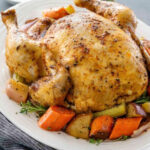by Buck Reed
For me, the best meals are the ones made simple. Yes, I like steak and lobster as much as the next person, and I can appreciate a wonderful sauce on a painstakingly made dish. But, for me, I really enjoy simple, well-made meals. Simple means uncomplicated, and it also means nowhere to hide. If you overcook it, there is no sauce to save it…which brings us to the glorious chicken.
A whole roasted chicken, when prepared and cooked correctly, is a masterpiece to behold. Taking the time to learn how to do it correctly is time well spent.
To start, address your chicken. Look for a whole chicken with no broken bones or holes in the skin. Remove any large deposits of fat from the cavity, as well as the neck and the gizzards.
If you can, brine your whole chicken in about three-quarters cup of salt per gallon of water, for three to eight hours in the refrigerator. If you do not brine the chicken, then there are two schools of thought: wash your bird or not. Both are acceptable; just make sure you have a good reason whichever you decide.
Next, you will need a proper roasting pan. A heavy-duty, high-sided roasting pan is essential for conducting heat evenly. In a pinch, you can use a large saute pan that is oven-safe.
While the chicken is brining, take some time to chop up some vegetables and put them in the bottom of the pan. I like red-skinned potatoes, baby carrots, and sliced turnips or parsnips, seasoned with garlic and just about any herb you want to flavor them with, as well as a bit of salt and pepper.
Season your dried chicken with salt, pepper, and any other spice you would like. Don’t forget to season the cavity as well. I like thyme, Old Bay, and sometimes, Cajun spice. Place the chicken on top of the vegetables, breast side up, and tuck in the wings.
Roast the chicken at 375° until the juices run clear when a sharp knife is inserted into the joint between the body and the thigh or until an instant-read thermometer registers 165° at the same joint (about 60 minutes).
After you remove the chicken from the oven, give it a rest. Remove the chicken from the pan and cover with aluminum foil. Roasted meat’s internal temperature will rise about 10 degrees while resting. The natural juices will also reincorporate into the meat’s fibers and the skin will dry out slightly.
While the bird is resting, check your vegetables to see if they are done. If they are not, strain out the drippings, reserving for a pan gravy if you want, and cook the vegetables longer. Once the vegetables are cooked, serve as a side dish with your chicken.
This is a nice one-pan dinner that is easy to prepare, inexpensive, and everyone should enjoy. You might not be the King or Queen of England, but I am sure you will be considered a monarch at your dinner table.


